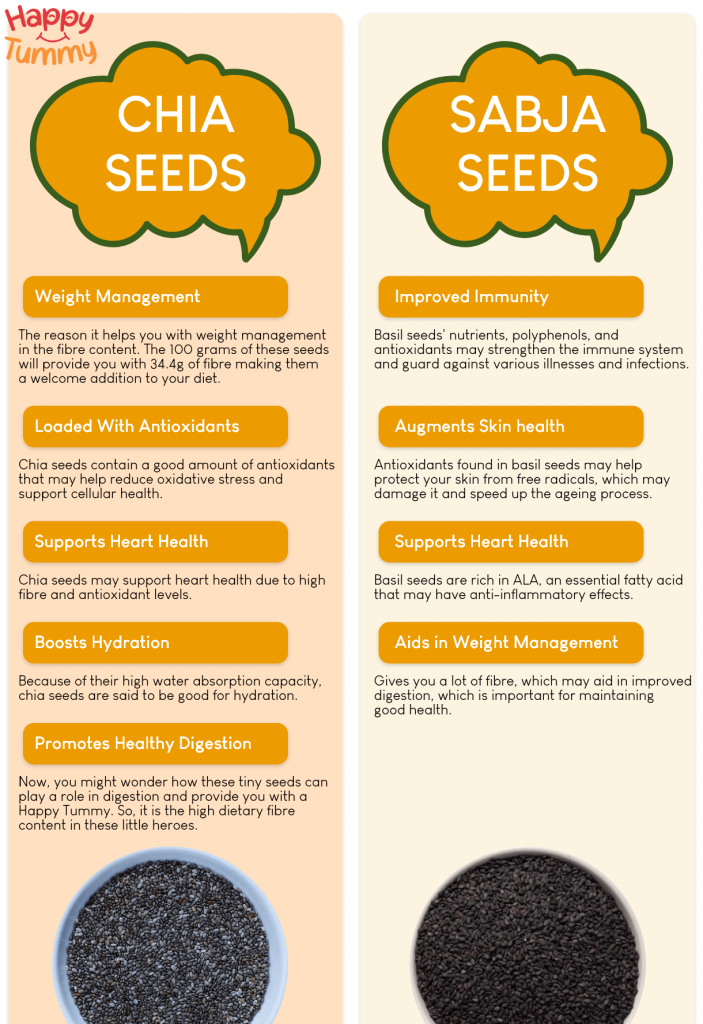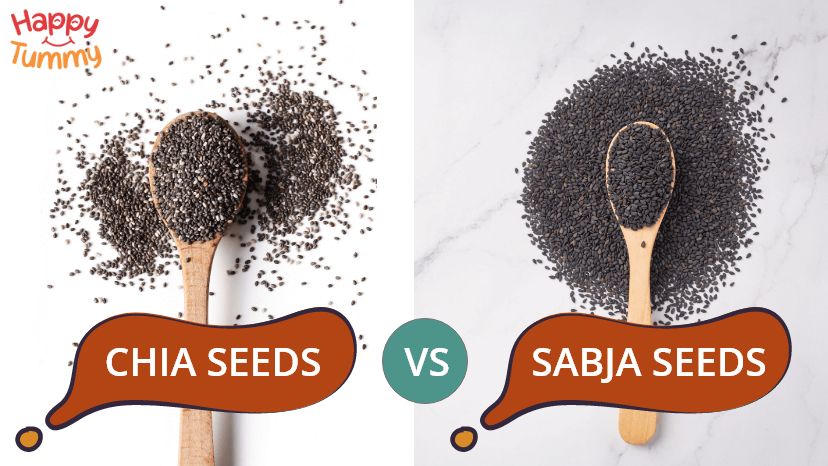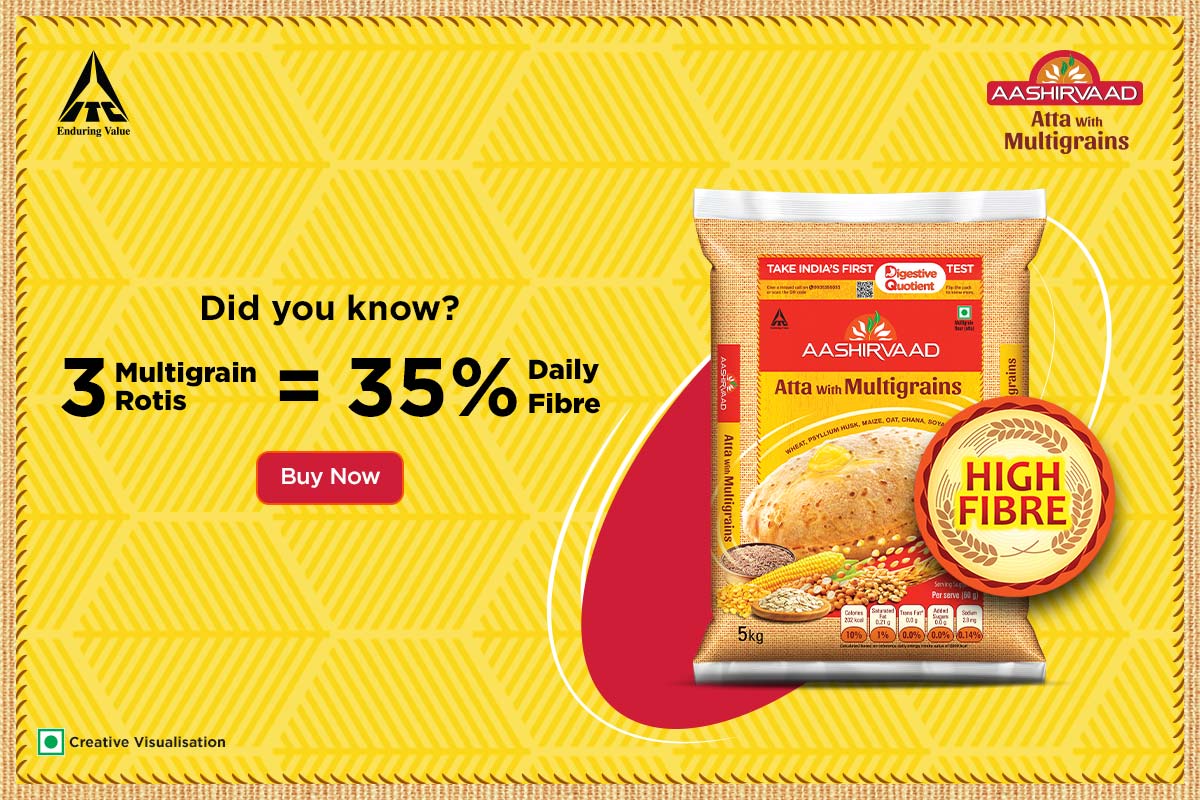Table of Contents
Nowadays, seeds are used in almost everything, which makes them an important part of nutritious diets. It might be challenging to choose which one is ideal for your needs, though, because there are so many varieties available.
Chia and basil seeds often take centre stage when discussing superfoods due to their exceptional nutritional profiles and versatility in the kitchen.
Given their many benefits for enhancing meals and physical health, both have earned a place in diets that prioritise health.
These seeds are appropriate for a range of dietary objectives and preferences due to their variations, despite their commonalities.
This article will provide you a detailed guide to both chia and sabja seeds and compare their nutritional value.
What Are Chia Seeds?
Chia seeds, also known as Salvia hispanica or Salba Chia in technical terminology, are small, oval-shaped seeds.
They originate from Salvia hispanica L., a herbaceous plant that is a member of the mint family. When raw, these magic seeds are crisp and mildly flavoured, but when soaked, they take on the consistency of a sponge.
Beginning with the ancient Mexican and Central American civilisations, these small seeds have a long and fascinating past. Recently, chia seeds have gained popularity.
They may be easily found at health food stores and are commonly utilised in a variety of cuisines.
Among the Indian states that cultivate these seeds are Madhya Pradesh, Andhra Pradesh, Gujarat, Karnataka, Rajasthan, and Haryana.

Health Benefits of Chia Seeds
The health benefits that chia seeds provide you with will give you enough reasons to consume it.
They are packed with countless nutrients that are essential for you wellness. Among them are;
1. Weight Management
When it comes to eating healthy and staying fit, chia seeds win the race. The reason it helps you with weight management in the fibre content. The 100 grams of these seeds will provide you with 34.4g of fibre making them a welcome addition to your diet. [1]
A typical serving is one tablespoon or 15-20 grams. However, please consult your dietician.
Its high fibre content and water-absorbing ability can create a sensation of fullness, which may manage the chance of overeating later.[2]
2. Loaded With Antioxidants
Chia seeds contain a good amount of antioxidants that may help reduce oxidative stress and support cellular health.
When it comes to detoxifying your body of free radicals that are present in your cells, the role of antioxidants becomes crucial. Free radicals seriously harm the body.
These free radicals can speed up the ageing process and have the ability to destroy cells or damage brain nerve cells. Antioxidants, however, save the day.
Eating antioxidant-rich foods, like chia seeds, may help manage skin health by reducing oxidative stress, delaying aging by minimizing cellular damage, and managing inflammation to promote overall wellness. [3]
3. Supports Heart Health
Maintaining heart health is one of the essentials for a long and healthy life; chia seeds may support heart health due to high fibre and antioxidant levels.
This might lower the body’s levels of low-density lipoprotein, or LDL, which is an unhealthy form of cholesterol. Additionally, there are about 407 mg of potassium in 100 grammes of chia seeds. [4] Potassium may help regulate blood pressure, which might benefit heart health. [5]
However, no single food can boost heart health on its own; instead, emphasizing a healthy lifestyle and a balanced diet, with chia seeds as one component, can contribute to overall cardiovascular health.
4. Boosts Hydration
Because of their high water absorption capacity, chia seeds are said to be good for hydration. The gel-like substance called mucilage, allows them to retain water when soaked. [6]
Therefore, pairing chia seeds with plenty of water can help maintain hydration while providing you with the nutritional advantages of the seeds.
This is particularly helpful in the morning after a full night’s sleep since your body needs to rehydrate in order to begin the day.
Pro tip: Boost your chia seed hydration by adding a few fresh mint leaves. A couple of drops of lemon juice will enhance the benefits for an extra refreshing twist!
5. Promotes Healthy Digestion
Drinking chia seed water may also be great for your digestion. Now, you might wonder how these tiny seeds can play a role in digestion and provide you with a Happy Tummy.
So, it is the high dietary fibre content in these little heroes. When combined with water, the gel-like material may support healthy bowel movement.
As a result, chia seed water promotes gut health and general well-being while acting as a natural remedy for indigestion.[7]
You can occasionally feel perplexed regarding your digestive quotient. However, things get simpler with Aashirvaad Digestive Quotient. Aashirvaad Atta with Multigrains and a team of expert nutritionists, have designed the Digestive Quotient test to check your digestive score out of 100.
Ways to Consume Chia Seeds
It’s really simple to include chia seeds in your diet. You can add them to almost anything because they have a very neutral flavour. They are a useful addition to recipes because you don’t have to grind, cook, or do anything else to them.
They may be added to muesli, pudding, smoothies, or baked products or consumed raw or soaked in juice.
Additionally, you may sprinkle them over rice dishes, veggies, yoghurt, or porridge. Plus, they work wonders in homemade fritters as a binding agent.
Given their ability to absorb water and fat, chia seeds can be used to thicken sauces and as an egg substitute. They can also be combined with water to form a gel. You may try the Chia Seed recipe below.
#Recipe: Chocolate Chia Seed Pudding
Healthy chocolate chia seed pudding is a great breakfast, dessert, or a snack. This simple dish requires only six ingredients and takes ten minutes to prepare.
Total Cooking Time: 10 minutes
Serving Size: 3-4 people
Ingredient
- 1½ cups almond milk
- ⅓ cup chia seeds
- ¼ cup unsweetened cocoa powder
- 4 tablespoons maple syrup
- A pinch of Aashirvaad Salt Active
- ½ teaspoon vanilla extract
Method
Making chocolate chia pudding is quite simple. There are just four steps involved. A little mixing and chilling will produce a big dish of chocolate pudding that tastes great. Preparation should take five to ten minutes.
Mix the chia seeds, cocoa powder, and salt in a large mixing bowl. Add the almond milk, maple syrup, and vanilla and mix to combine. Mix well with a whisk. Let sit in the fridge for an hour, then mix. After that, leave it for a minimum of two more hours. Leave the pudding overnight to allow it to set.
Stir with a little almond milk just before serving. Fun toppings are optional, but they are not necessary. Most importantly, enjoy!
What Are Sabja Seeds?
These little black seeds, also known as sweet basil or sabja, are all you must include in your daily diet to reap the wonderful health advantages.
Often mistaken for chia, these tear-shaped kernels from the Ocimum basilicum family are also referred to as falooda seeds, turkmaria/tukmaria, Sabja ginjalu in Telugu, and Sabja vithai in Tamil.
These seeds of a delicate, medium-sized plant are cultivated in warm, tropical climates and are prized by Ayurveda and Chinese medicine for their numerous therapeutic and health advantages.
These seeds, which are indigenous to India and other Southeast Asian nations, have been grown for over 5000 years and are considered vital components of Thai, Vietnamese, Italian, and Indian cuisines, particularly in sweets.
Health Benefits of Sabja Seeds
Drinking lemonade by the roadside in the sweltering summer heat will incredibly cool your body. The unique component that makes that drink cool is the sabja seeds.
Its numerous health benefits are as follows:
1. Improved Immunity
Basil seeds’ nutrients, polyphenols, and antioxidants may strengthen the immune system and guard against various illnesses and infections.
Additionally, the iron in basil seeds might promote the synthesis of red blood cells, essential for delivering oxygen throughout the body.
Basil seeds also contain fiber, which may aid digestion and support gut health, further enhancing the body’s natural defense mechanisms.
Their anti-inflammatory properties may help manage inflammation, promoting faster recovery and improved overall wellness.
Thus, the immune system can operate at its best and successfully fend off infections. [8]
Please note, however, that including sabja seeds along with a good diet and lifestyle may help build immunity
2. Augments Skin health
Everyone wants to have skin that glows brightly. With age, oxidative stress affects skin health. However, antioxidants found in basil seeds may help protect your skin from free radicals, which may damage it and speed up the ageing process.
Soaked basil seeds have a gel-like consistency that may help moisturise the skin from the inside out.
Hydrated skin may be the reason for the luster and shine. It also includes flavonoids, which may help manage skin irritation, acne, and inflammation. [9]
Consequently, regular use of basil seeds water along with a clean diet encourages skin that is healthier and more beautiful.
3. Supports Heart Health
One of the ways to keep your heart healthy is avoiding bad cholesterol. Dietary intake of polyunsaturated fatty acids and essential fatty acids like ALA may support heart health .
Basil seeds are rich in ALA, an essential fatty acid that may have anti-inflammatory effects.[10]
Additionally, polyphenols, which are antioxidants found in basil seeds, have been connected to managing the prevalence of cardiovascular diseases.
4. Aids in Weight Management
These seeds get heavier after soaking in water for at least 20 minutes, and eating them prolongs feelings of fullness.
Additionally, eating these amazing seeds gives you a lot of fibre, which may aid in improved digestion, which is important for maintaining good health. [11] Because fibre promotes feelings of fullness, it may help lessen cravings and overeating.
Ways to Consume Sabja Seeds
When soaked, basil seeds have a gelatinous texture and a moderate flavour, which makes them simple to include into sweets and beverages.
This is how basil seeds are often used in several Asian countries. Falooda, a favourite dessert in many regions of India, is an example.
People might begin by soaking basil seeds in water before adding them to a recipe.
The majority of recipes suggest soaking them for 30 to 2 hours before straining out the water, however this varies from recipe to recipe. After straining, the seeds can be used as a topping or mixed into:
- Chilled desserts
- Milkshakes and smoothies
- Lemonade or other beverages
- Yoghurt
- Muesli
Instead of soaking basil seeds in water, people may ground them up and use them in baking preparations.
#Recipe: Sabja Lemonade
Don’t you believe that fresh lemonade is the nicest beverage on a hot day? When life throws you a curveball, try this cool Indian lemonade or sabja nimbu pani, with fragrant basil seeds and fresh mint.
Total Cooking Time: 20 minutes
Serving Size: 2 people
Ingredients
- 1 Lemon
- 3 tablespoons strawberry Syrup
- 2 Glass of Chilled Water
- 2 Teaspoon Sabja Seeds
- 4 to 5 Mint Leaves
- Pinch of Aashirvaad Himalayan Pink Salt
Method
Rinse and soak the seeds in warm water for 10 to 15 minutes. Strain out the excess water and set it aside. Combine the lemon juice, strawberry syrup, and cold water in a container. Stir well.
Stir in the strained seeds, then pour into a glass. Add the salt and mint leaves. You may serve them cold by adding ice cubes.
Chia Seeds vs Sabja Seeds: A Comprehensive Comparison of Nutritional Profile
Because of their numerous health advantages, chia and sabja seeds are strongly advised for weight management, better digestion, and general well-being.
Let’s examine how these nutritional powerhouses stack up in terms of certain health metrics:
| Nutrient | Chia Seeds [12] | Sabja Seeds (Basil Seeds) [13] |
| Calories | 486 kcal | 233 kcal |
| Protein | 16.5 g | 23 g |
| Carbohydrate | 42.1 g | 47.8 g |
| Dietary Fiber | 34.4 g | 37.7 g |
| Calcium | 631 mg | 2240 mg |
| Iron | 7.22 mg | 89.8 mg |
| Potassium | 407 mg | 2630 mg |
| Magnesium | 335 mg | 711 mg |
| Phosphorous | 860 mg | 274 mg |
| Fatty Acid Total Saturated | 3.33 mg | 2.16 mg |
Key Takeaways:
Sabja seeds are perfect for people who need additional calcium, iron, magnesium, and potassium. Chia seeds are appropriate for energy-demanding exercises since they offer more calories and phosphorus.
Sometimes, you may find it difficult to plan healthy meals and always look for strategies to increase your fibre intake. But wonder who to counsel and how to approach it.
Well, fear not, folks—Aashirvaad Atta with Multigrains and a team of trained nutritionists have created the My Meal Plan test, which may determine your daily fibre intake and provide you with a comprehensive meal plan that complies with recommended intake.
Both basil and sabja seeds have incredible nutrition profiles with diverse health benefits that might give you a highly healthy life.
Their nutritional facts make them versatile and invaluable tools for managing your health since they contain antioxidants, fibre, and essential minerals.
Because both seeds are quite nutrient-dense, their inclusion in a balanced diet will depend on dietary choices and one’s health goals.
Long Story Short…
Chia and sabja seeds are nutritional powerhouses that can significantly enhance a balanced diet. Because of their distinct profiles of vital nutrients, such as protein, dietary fibre, and healthy fats, complement any health-focused diet plan.
Including these seeds in your daily routine can have various health advantages, including helping you manage weight, control blood sugar, and strengthen your heart.
But to reap the full benefits, make sure you eat them as part of a well-balanced diet.
As usual, speaking with a healthcare provider before making big dietary changes is best, especially if you already have health issues.
Contact our certified nutritionist for a 45-minute consultation to plan your best meals.
Frequently Asked Question
You must speak with a healthcare professional before eating these seeds when pregnant or nursing.
Your needs will determine whether you choose chia or Sabja seeds; chia seeds are better for omega-3 and versatility, while Sabja seeds are better for hydration and cooling qualities.
One of these seeds’ main advantages is their high fibre content. Having these seeds just before meals may help your body manage blood glucose levels without generating an unneeded surge when you eat, especially if you have diabetes.
Both seeds may lead to bloating or gas because of their rich fibre content. They may be choking hazards if not soaked appropriately. Side effects include allergic reactions and chia seeds’ blood-thinning properties, and thus, people who are on blood-thinning medications should consult a doctor before taking them. If you develop allergies or digestive issues or are on medications, you must consult a doctor before taking sabja or chia seeds.















